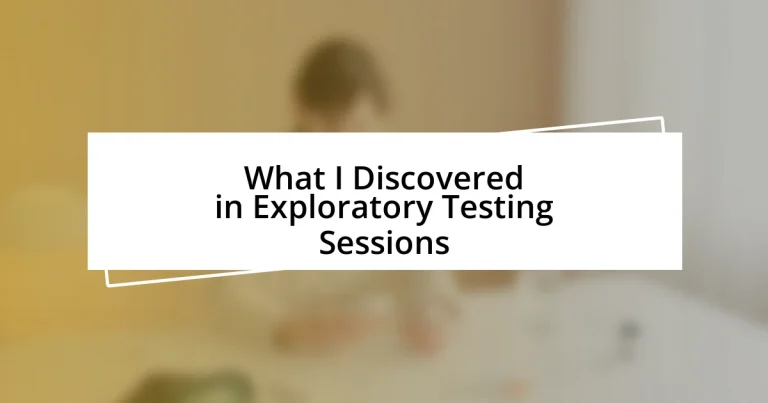Key takeaways:
- Exploratory testing fosters creativity and user empathy, leading to enhanced bug discovery and a deeper understanding of user experiences.
- Key steps include preparation with clear objectives, real-time documentation of findings, and post-session reflection for continuous improvement.
- Effective techniques involve using charters to guide focus, paired testing for diverse perspectives, and thorough documentation to ensure clear communication of insights.
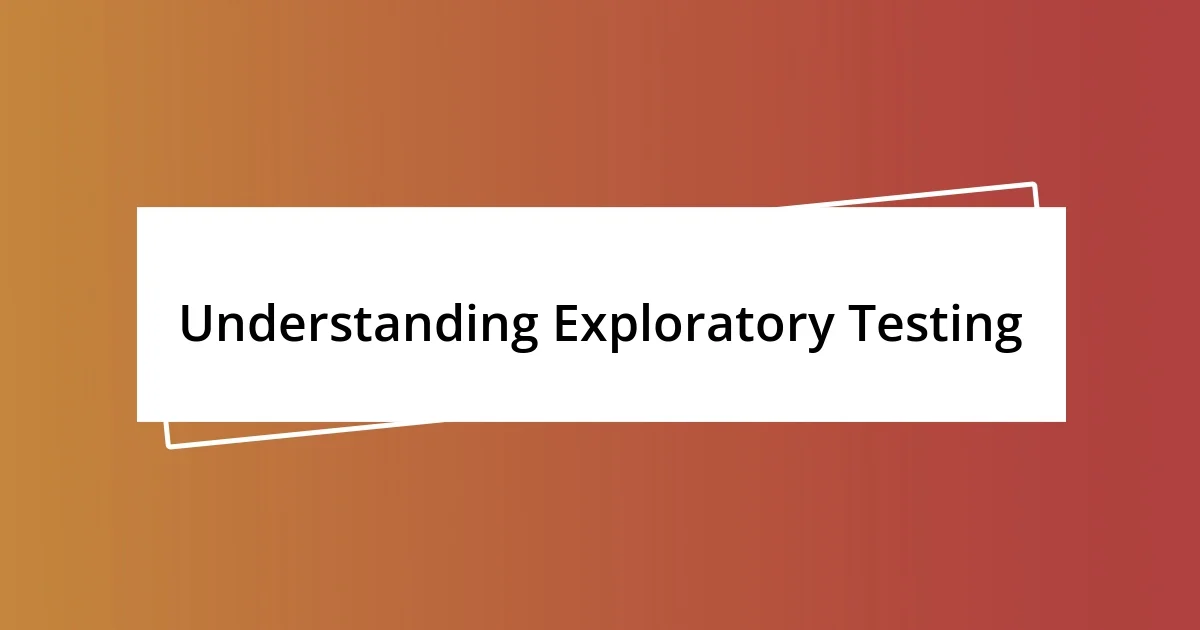
Understanding Exploratory Testing
Exploratory testing is such an intriguing approach to software quality, don’t you think? For me, it feels less like following a rigid script and more like embarking on an adventure where I uncover unexpected issues. I recall a session where I stumbled upon a critical bug simply by trying out various user scenarios, which I wouldn’t have thought to test in a structured way.
It’s fascinating how exploratory testing encourages intuition and creativity. I often find myself drawing on my experiences as a user, thinking about how others might interact with the software. The emotional connection I develop during testing can sometimes reveal insights that traditional methods might overlook—it’s like seeing the software through a user’s eyes, filled with their hopes and frustrations.
When I engage in exploratory testing, I’m actively questioning everything. Why does this button behave that way? How does this change affect user flow? Each question opens new avenues for discovery, allowing me to delve deeper into the application’s functionality. This mindset transforms testing from a mundane task into an exciting quest for quality, making each session an opportunity for impactful learning.

Benefits of Exploratory Testing
Exploratory testing offers a wealth of benefits that can significantly enhance the overall quality of software. What I particularly appreciate is the flexibility it provides. Unlike traditional testing methods, exploratory testing allows me to focus on real-world user experiences. I can adapt my approach based on what I observe in the moment, making the whole process dynamic and intuitive. For instance, during one of my recent sessions, I tried using the application without any guidance, which led me to discover a feature that was nearly hidden but critical for user navigation.
Here are some key benefits I’ve noticed over time:
- Enhanced Bug Discovery: Unstructured exploration often leads to the identification of hard-to-find defects.
- User-Centric Perspective: Testing as a real user fosters empathy and a better understanding of user behavior.
- Quick Feedback Loops: Immediate results can inform developers quickly, allowing for agile adjustments.
- Skill Development: I find that my intuition and critical thinking sharpen with each testing session, making me a better tester overall.
By approaching software with an open mind, I uncover nuances that would likely elude conventional testing methods. Each session is a unique experience, filled with unexpected discoveries and learning moments that enhance my expertise and contribute to the project’s success.
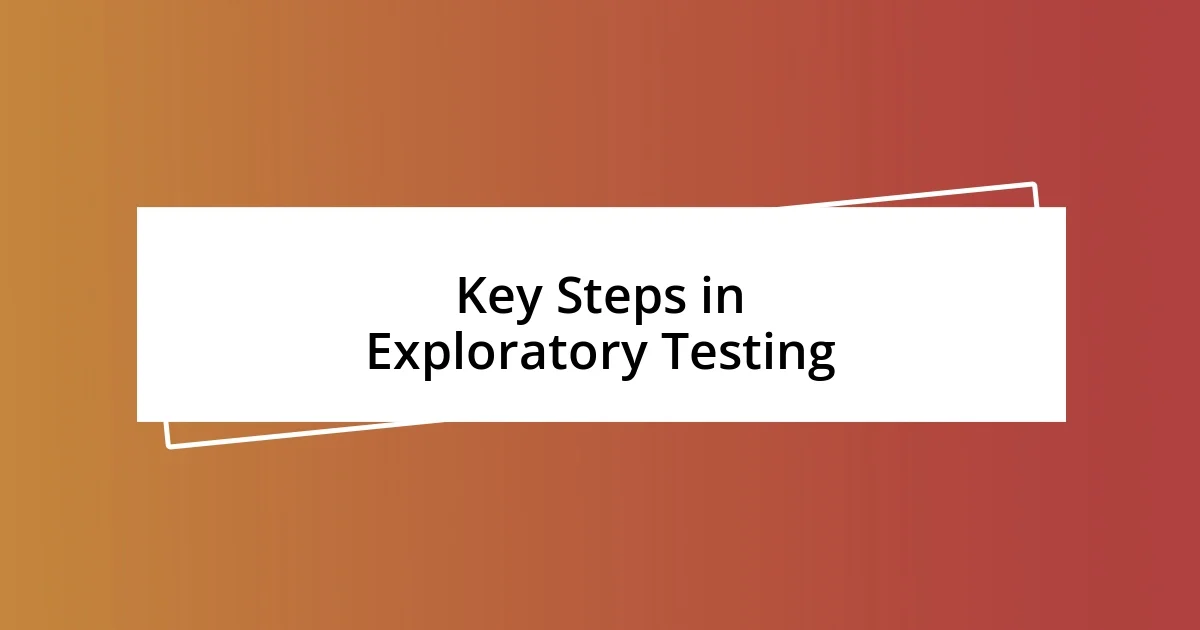
Key Steps in Exploratory Testing
When it comes to key steps in exploratory testing, I typically find that preparation is essential. I like to start by setting clear objectives for my session, defining what areas I aim to explore. For instance, in a recent exploratory session focused on a new feature, I outlined specific user journeys I wanted to test. This initial step not only guides my exploration but also helps to channel my curiosity effectively.
As I dive deeper into exploratory testing, I employ a technique I fondly call ‘live documentation.’ I jot down my thoughts, findings, and questions in real-time. I remember one instance where I discovered a functionality that created confusion for users. Documenting that moment allowed me to communicate it clearly with my team, sparking a riveting discussion on user experience. Capturing insights in the moment transforms them into actionable feedback, which is invaluable for any testing process.
Finally, I believe that reflecting on my findings is crucial. After each session, I take some time to analyze what I’ve encountered and how it aligns with the initial objectives. I recall a time when, after a testing session, I revisited my notes and realized I had overlooked a critical integration point. This reflection process allows me to continuously improve my approach and hone my instincts for future sessions.
| Step | Description |
|---|---|
| Preparation | Set clear objectives and outline user journeys to guide exploration. |
| Live Documentation | Document findings and questions in real-time to inform discussions and feedback. |
| Reflection | Analyze findings afterward to identify improvements and enhance future testing. |
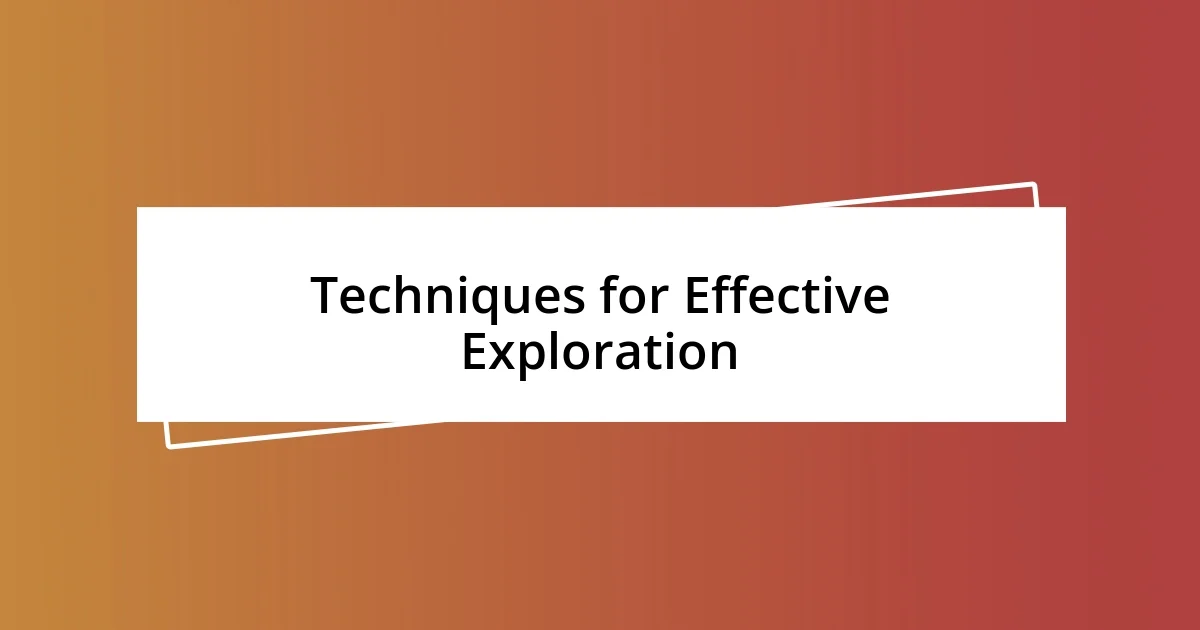
Techniques for Effective Exploration
When I think about techniques for effective exploration, one method stands out: the use of charters. These charters act as a guiding light during my sessions. By writing down a specific goal like “explore payment processing options,” I can maintain focus while still allowing room for spontaneity. This structured freedom often leads me down paths I hadn’t anticipated, helping me uncover issues that might otherwise slip through the cracks.
Another technique I’ve found to be immensely valuable is the practice of paired exploratory testing. In one memorable session, I partnered with a colleague. We took turns sharing our observations out loud, which not only enhanced our understanding but also sparked creative ideas we hadn’t considered individually. Have you ever tried exploring with a partner? It’s amazing how two sets of eyes can spot different nuances, making the exploration richer and more insightful.
Lastly, I can’t stress enough the importance of varied perspectives during exploration. When I switch roles—say, from a user to an admin—it completely alters my view of the software. I vividly recall a session where I approached the application as an administrator. Instantly, new features revealed themselves that I hadn’t noticed before. This shift in perspective often leads to unexpected discoveries, turning an ordinary testing session into a treasure trove of insights. How often do you mix up your roles during testing? It’s a technique I wholeheartedly recommend!
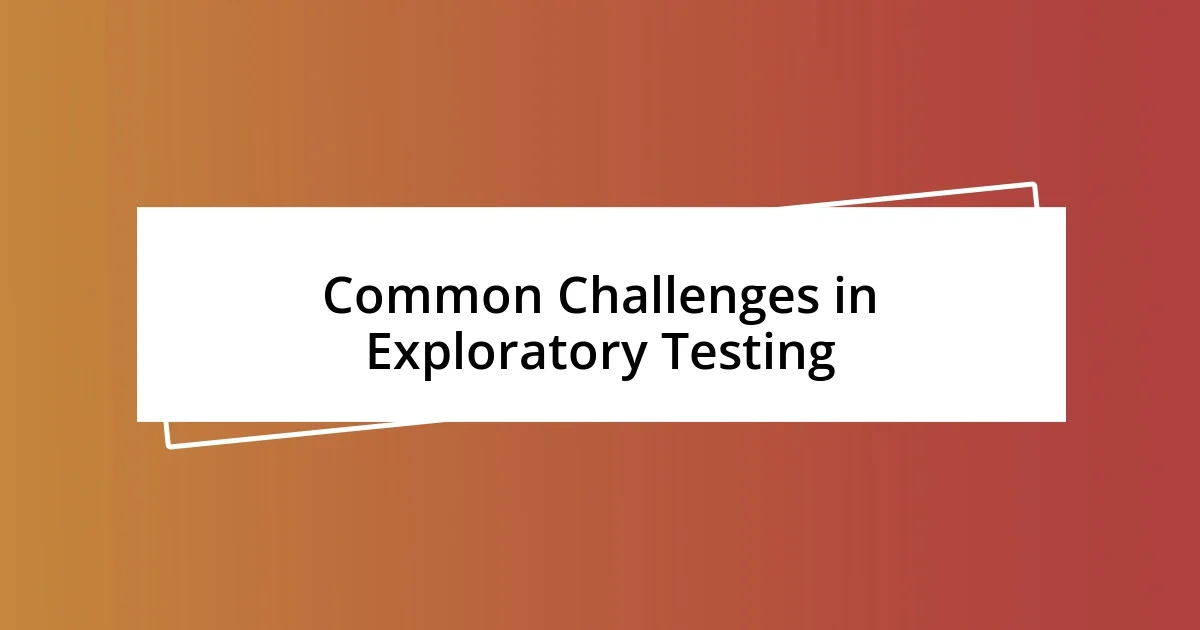
Common Challenges in Exploratory Testing
One recurring challenge I face in exploratory testing is managing time effectively. I often find myself engrossed in specific areas, sometimes forgetting the bigger picture. There was a testing session where I spent too long trying to uncover every detail in a single feature, only to realize later that I had missed exploring other critical functionalities. Have you ever lost track of time while testing? It can be frustrating, but it’s essential to set time limits and remind ourselves to strike a balance.
Another issue that crops up is the difficulty of reproducing specific bugs. It’s incredibly disheartening to discover a glitch that interrupts user experience, only to find that I can’t replicate it later in the same environment. I remember once stumbling upon a severe performance issue that vanished when I returned to document it. This inconsistency can make it challenging to communicate findings effectively. How do you handle such elusive bugs? Sharing insights with the team during discussions has proven beneficial for me, as we often uncover patterns together.
Lastly, I sometimes grapple with the feeling of inadequacy in my exploratory approach. During one testing session, I questioned whether my instincts were guiding me correctly. The pressure to uncover significant issues can weigh heavily. Have you felt this pressure too? In those moments, I remind myself that every tester has their strengths, and the goal is not perfection but progress. Embracing this mindset has made a noticeable difference in my exploratory sessions, allowing me to approach testing with a lighter heart.
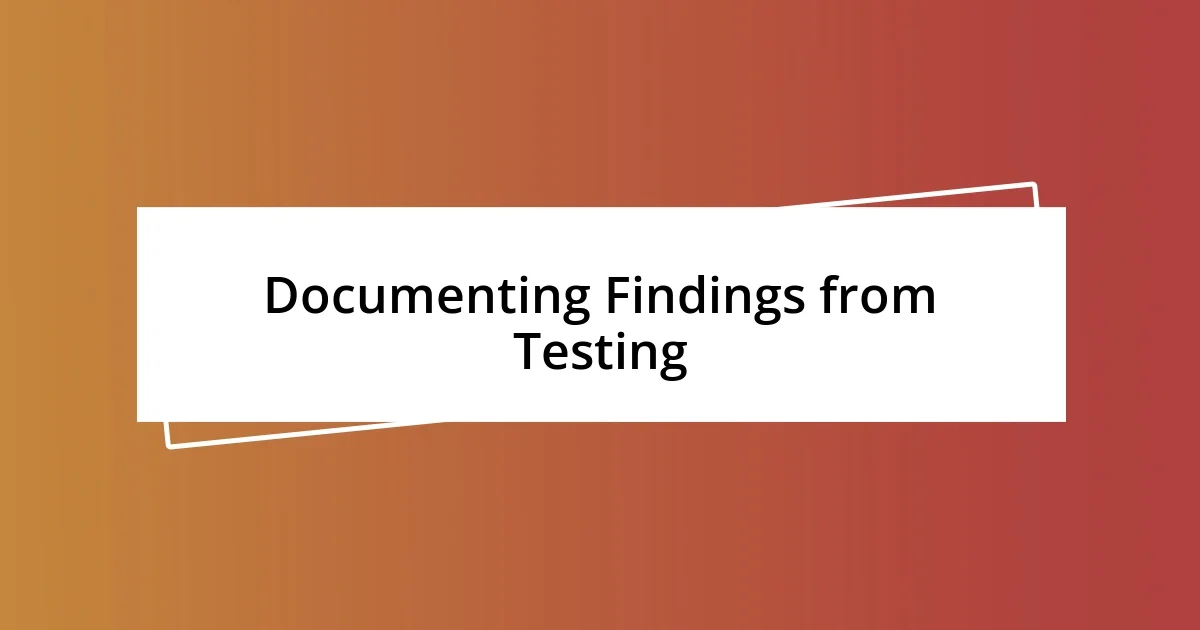
Documenting Findings from Testing
Documenting findings from exploratory testing can be a game changer. I always make it a point to jot down any bugs or inconsistencies as soon as I spot them. After all, the excitement of discovery can easily fade if I wait until the session ends. Have you ever lost a brilliant insight because you thought, “I’ll remember it”? Trust me, you won’t. It’s those little notes that often lead to significant discussions later.
One method I’ve found helpful is creating detailed, yet concise, reports after each session. I tend to use screenshots and short video clips to illustrate my findings vividly. I recall a time when I documented a confusing user interface scenario, complete with a video. Sharing that with my team led to a deep conversation about user experience, sparking ideas for improvements we never considered otherwise. How much more effective could your team be if they could see exactly what you encountered? Visuals can bridge those gaps in understanding.
Lastly, I can’t recommend the practice of tagging findings enough. By labeling issues based on severity—like critical, major, or minor—I create a prioritized list that helps the team focus their efforts. In a recent project, this tagging system allowed us to address a major flaw that could have gone unnoticed otherwise. Have you ever faced a situation where a small bug snowballed into a larger issue? My tagging process helped us avert such disasters by ensuring we were all on the same page, quite literally.
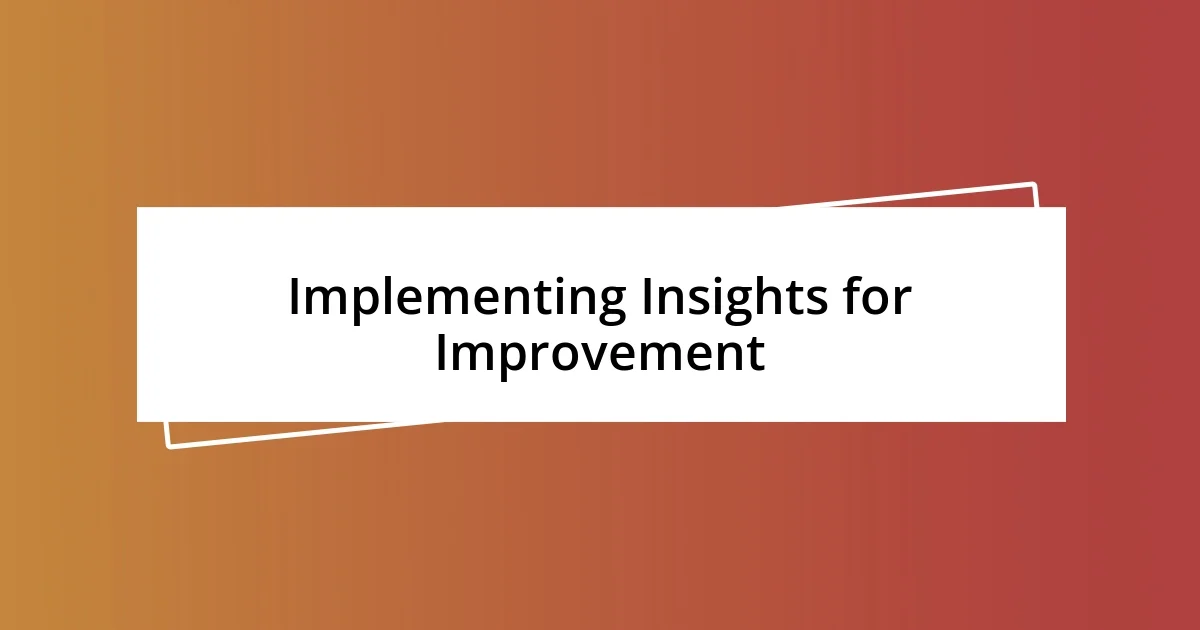
Implementing Insights for Improvement
I’ve discovered that implementing insights from exploratory testing sessions can feel like piecing together a puzzle. I remember a time when a minor bug, easily overlooked, turned out to reveal a critical flaw in the design. This experience taught me that even the smallest observation can lead to significant enhancements. Have you ever noticed how small details can bring about the biggest changes? It’s all about being open to insights and acting on them swiftly.
Another effective strategy I adopted is conducting collaborative post-session reviews. I vividly recall a session where we grouped together to discuss our findings, sparking a lively conversation that led to creative solutions. It’s amazing how bouncing ideas off each other can unearth unique perspectives. How often do you seek input from peers to refine your insights? Incorporating diverse viewpoints not only broadens the understanding of the issue but also fosters a sense of teamwork.
Furthermore, I prioritize action items based on the insights uncovered. After one particularly fruitful testing session, we generated a list of enhancements that felt tangible and urgent. Assigning ownership for each task transformed abstract ideas into actionable plans that the team could rally around. Isn’t it empowering when insights translate into real improvements? I find that this approach not only boosts productivity but also instills a sense of accomplishment as we see our collective efforts bear fruit.












